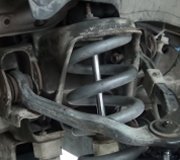"Lumpy" is a technical term that refers to a broken belt in the tire. Your dandy observation that it looked "bent" is the clue. There are other ways to have a broken belt that are real subtle and hard to find unless you know what to look for. The typical complaint with those is the vehicle pulls to one side on the road, but in a parking lot you'll see the steering wheel oscillate back and forth a little once per wheel revolution.
One common cause of a broken belt is hard impact. I made a 1500 mile trip last month that included two runs through Indiana where they haven't learned yet about "Bump Ahead" road signs. My '88 Grand Caravan daily driver is so rusty I thought it was going to split in half a few times. Thank goodness the carpet is still in good shape to hold the van together! I had to rearrange my kidneys after hitting a few of those bumps, and I still find it hard to believe I didn't blow a tire.
Another common cause of a broken belt is a tire that has had a hole patched. The patch does a fine job of preventing the air from falling out, but water can go into that hole and corrode the steel wires that make up the belts. That's much more common in states like Wisconsin where we throw a pound of salt on an ounce of snow. To prevent this, plug the tire first, then dismount it, cut the plug off flush inside, then put the patch over the hole. The plug will do a great job on its own if the hole is in the tread, but they aren't supposed to be used on sidewalls because there's too much flexing. Some states may have laws against using plugs on sidewalls, but even if they don't, most shop owners don't allow them there for liability reasons. Patches aren't recommended on sidewalls either, but I have used them on my own tires a few times and never had one let go. There's no steel belts in the sidewall to corrode so a plug won't do any good if a patch is used.
In the '80s when I worked for a mass merchandiser in their Auto Shop, we replaced two or three sets of General tires every day due to broken belts. They always came as original equipment on GM vehicles. Uniroyal tires were also notorious for broken belts. They were hard to sell because of their reputation. This had to be a design issue because it was so common to see them with this problem, even when they had very low mileage.
All through the '90s I was the suspension and alignment specialist at a very nice family-owned Chrysler dealership. I was always taking home old tires to use on my stuff, and since most Chrysler products came with Goodyear tires as original equipment, that's mostly what I had. I ran into a lot of broken belts, and almost every time it happened when that tire should have already been replaced. There's something about my van that will not allow it to get stuck in a snow drift that I can't get out of by myself, even with almost-bald tires, and that's why I ran them way past their tread life, but hydroplaning becomes a serious safety issue. If I found my tires on anyone else's vehicle, I would have rolled my eyes if they didn't want to have them replaced. This is a case of "do as I say, not as I do".
You may want to visit the dealer for your tire brand to see if it is still under warranty. You may get a few dollars but that might be based on the amount of tread remaining. Also, to get those dollars you typically have to buy another tire of the same brand. That usually means paying more compared to farm and home type store prices.
The previous reply is right about getting that tire off right away. I've limped along on a couple for 50 to 100 miles that were bad enough to knock my teeth out, but I got lucky. I also had one last year that most people wouldn't have noticed. Managed to sneak out a couple of thousand miles but it blew out on the highway and forced an emergency pit stop. It's sad that I'm used to changing tires on the side of the road and can do it pretty quickly, but that's not a position I want to put my customers in.
All of this sad story assumes you see that wobble in just the tire and not the wheel. A bent wheel will cause the same feeling while driving, but a new tire obviously isn't going to fix that. If there's a tumor, or raised spot on the tire, or the tire tread has a squirming pattern to it, you'll almost always see a patch where the tread is worn down much more than on the rest of the tire, and there is very likely to be wires from the steel belt sticking out. Be very careful to not slide your hand over those wires. They really smart when you get poked with them.
Friday, October 17th, 2014 AT 11:44 PM


